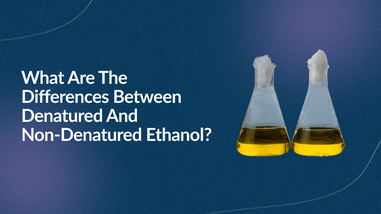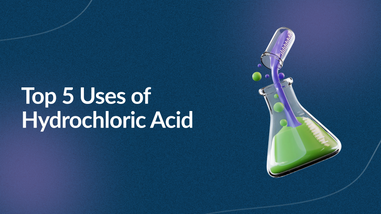- No products in the cart.
Some things just sound like they belong together. One of these is ethanol and methanol. There are some similarities between the two. They sound alike, look alike, are colorless liquids, and are types of alcohol or chemicals. Because of the similarities, it’s easy to mistake one for the other. However, they do have some stark differences. They are different types of alcohol, have different properties, and are created used for different things.
Methanol
Methanol, also known as wood alcohol or methyl alcohol, is a chemical that presents itself as a colorless, volatile, and flammable liquid and is the simplest form of alcohol. It is a combination of carbon monoxide gas and hydrogen in addition to a catalyst. Methanol is often used to produce a variety of other chemicals. Small amounts are found naturally in fruits and vegetables.
Here are some of its properties:
- Molar mass: 32.04 g/mol
- Boiling point: 148.5℉ (64.7℃)
- Formula: CH3OH
- Density: 792 kg/㎥
- Melting point: -143.7℉ (-97.6℃)
- Mol: 32.04 g mol
- Classification: Alcohol
Top Industrial Uses:
Pure methanol is critical when it comes to the construction of complex chemical compounds from simpler ones. It is used to form synthetic dyestuffs, pharmaceuticals, resins, and perfume. It’s also used as an anti-freeze for automobiles, a general solvent, and rocket fuel. Methanol is also a high-octane fuel that can be used in cars.

Chemical Warnings:
Methanol can create explosions and burns with a flame that does not emit light. The chemical is poisonous if consumed.
When handling Methanol, avoid direct exposure. Face, eyes, and skin should always be covered when working with methanol. If vapors are present, make sure you have proper ventilation. Methanol should never be left open to the air.
Ethanol
Ethanol, also known as ethyl alcohol or grain alcohol, is an organic chemical compound that is a clear, colorless, flammable liquid with a heavy burning sensation. It is produced naturally by fermenting sugars by yeast or through a process such as ethylene hydration. Ethanol dissolves easily in water. Ethanol is comprised of combining an ethyl group with a hydroxyl group.
Ethanol does have some benefits to the environment. It is non-toxic, reduces pollution, and is biodegradable. It also produces a cleaner burn and has higher octane levels than gasoline.
Here are some of its properties:
- Molar mass: 46.07 g/mol
- Boiling point: 173.1℉ (78.37℃)
- Formula: C2H50H
- Density: 789 kg/㎥
- Melting point: -173.5℉ (-114.1℃)
- IUPAC ID: ethanol
- Cas: 64-17-5 noaa.gov
Top Industrial Uses:
Ethanol is used to synthesize other organic chemicals, used as a solvent, and as an additive to gas for automobiles. It is also an ingredient in alcoholic beverages such as wine, beer, and brandy.
Chemical Warnings:
Ethanol is toxic. It affects the central nervous system. Moderate amounts produce a relaxing effect on the body, while more significant amounts impair judgment and coordination and lead to a coma and death. It can also be addictive and lead to alcoholism.
Differences
While methanol and ethanol are both alcohols, they are very different types of alcohol. Ethanol is formed by combining an ethyl group to a hydroxyl group, and methanol is created by combining a methyl group to a hydroxyl group. Ethanol has two carbon atoms, while methanol is only one atom. Ethanol is less acidic than water, and methanol is more acidic than water.
Ethanol has a burning smell and emits a bright blue flame. Methanol has its characteristic odor and, when burning, emits a light white flame. Ethanol is prepared by fermentation, while methanol is processed through synthetic processes. Ethanol is the main ingredient of alcoholic beverages, while methanol is highly poisonous and should not be consumed. Methanol is primarily used in the manufacturing of products such as formaldehyde.
Methanol has more risks involved with it than ethanol. Methanol is flammable, toxic, and poisonous if ingested, inhaled, or in contact with the skin. Ethanol is toxic, flammable, and is safe for consumption as a critical ingredient of alcoholic beverages. It can be a dangerous chemical if pure alcohol is ingested. Ethanol is more environmentally friendly and safer than methanol.
Lab Pro offers a large variety of chemicals and laboratory supplies. For over 40 years, Lab Pro Inc. has been committed to delivering the highest quality chemicals, tweezers, and hard-wire cutters, lab supplies, and cleanroom PPE apparel to medical device and electronic manufacturing companies and laboratories worldwide. To learn more, visit the biggest Lab Supply showroom in California, or contact us online at 888-452-2776.












































